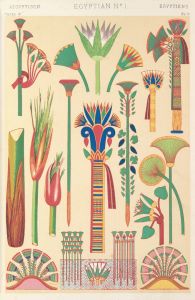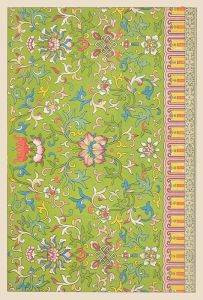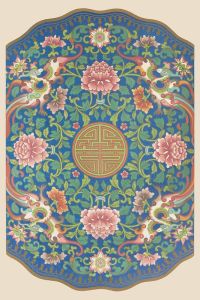
Examples of Chinese ornament, Pl.88
A hand-painted replica of Owen Jones’s masterpiece Examples of Chinese ornament, Pl.88, meticulously crafted by professional artists to capture the true essence of the original. Each piece is created with museum-quality canvas and rare mineral pigments, carefully painted by experienced artists with delicate brushstrokes and rich, layered colors to perfectly recreate the texture of the original artwork. Unlike machine-printed reproductions, this hand-painted version brings the painting to life, infused with the artist’s emotions and skill in every stroke. Whether for personal collection or home decoration, it instantly elevates the artistic atmosphere of any space.
"Examples of Chinese Ornament, Pl.88" is a plate from the influential design book "The Grammar of Ornament" by Owen Jones, first published in 1856. Owen Jones was a British architect and designer, known for his work in color theory and his contributions to the decorative arts. His book aimed to provide a comprehensive collection of design principles and examples from various cultures around the world, serving as a reference for designers and artists.
"The Grammar of Ornament" is divided into several chapters, each focusing on the ornamental styles of different cultures, including Egyptian, Persian, Greek, Roman, Arabian, Turkish, Indian, Chinese, and others. Plate 88 specifically showcases Chinese ornamentation, reflecting the intricate and symbolic designs characteristic of Chinese art.
Chinese ornamentation, as depicted in Jones's work, often features motifs such as dragons, phoenixes, flowers, and geometric patterns. These elements are not only decorative but also carry cultural and symbolic meanings. For instance, the dragon is a symbol of power, strength, and good fortune, while the phoenix represents renewal and immortality. Floral motifs, such as peonies and lotuses, are commonly used to symbolize beauty, purity, and prosperity.
Jones's depiction of Chinese ornamentation in Plate 88 highlights the use of vibrant colors and intricate patterns. The designs are typically symmetrical and balanced, reflecting the Chinese aesthetic principles of harmony and order. The use of bold reds, golds, and blues is prevalent, as these colors hold significant cultural meanings in Chinese tradition. Red symbolizes happiness and good luck, gold represents wealth and prosperity, and blue is associated with immortality and the heavens.
The inclusion of Chinese ornamentation in "The Grammar of Ornament" was part of Jones's broader effort to promote an understanding and appreciation of global design traditions. By presenting these designs to a Western audience, Jones aimed to inspire and educate designers about the rich and diverse heritage of ornamental art. His work played a crucial role in the 19th-century design reform movement, which sought to elevate the standards of design and craftsmanship.
Jones's meticulous documentation and analysis of Chinese ornamentation in Plate 88 provide valuable insights into the artistic traditions of China. His work continues to be a significant resource for historians, designers, and artists interested in the study of ornamental art. The detailed illustrations and descriptions in "The Grammar of Ornament" serve as a testament to the enduring beauty and complexity of Chinese decorative arts.
Overall, "Examples of Chinese Ornament, Pl.88" by Owen Jones is a remarkable representation of Chinese design, capturing the essence of its intricate patterns and symbolic motifs. It stands as a testament to the cross-cultural exchange of artistic ideas and the enduring influence of Chinese ornamentation on global design practices.

















